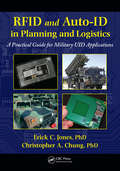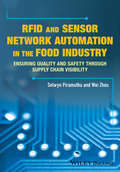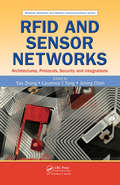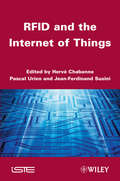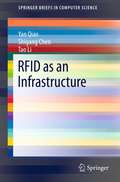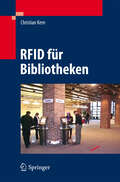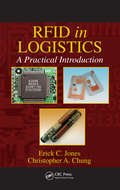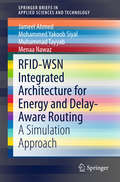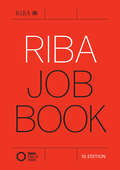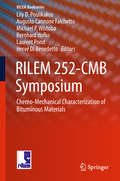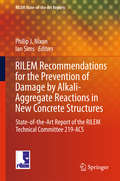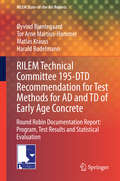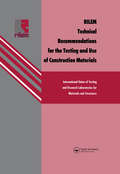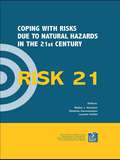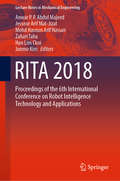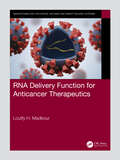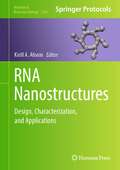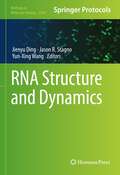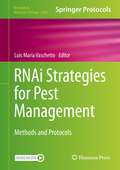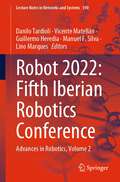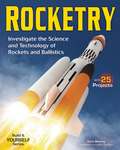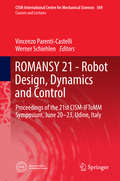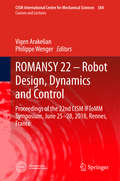- Table View
- List View
RFID and Auto-ID in Planning and Logistics: A Practical Guide for Military UID Applications
by Erick C. Jones Christopher A. ChungAs RFID technology is becoming increasingly popular, the need has arisen to address the challenges and approaches to successful implementation. RFID and Auto-ID in Planning and Logistics: A Practical Guide for Military UID Applications presents the concepts for students, military personnel and contractors, and corporate managers to learn about RFID
RFID and Sensor Network Automation in the Food Industry
by Weibiao Zhou Selwyn PiramuthuRadio Frequency Identification (RFID) is a key technology in the food industry that facilitates real-time visibility of items as they move through the supply chain and on to the end-consumer. Among all the currently available automatic identification technologies, RFID has clear dominance in terms of its ability to support real-time two-way communication, data storage and update, authentication, ambient condition sense and report, batch read without direct line-of-sight, operation in harsh environments and sensor-based applications. RFID and Sensor Network Automation in the Food Industry provides sufficient detail on the use of RFID and sensor networks from `farm to fork? (F2F) to allow the reader to appreciate the myriad possible applications of RFID and associated sensor network systems throughout the entire food supply chain. This includes precision agriculture, the provision of seamless visibility in track and trace applications, reduction of wastage, identification of counterfeits and contamination sources, remaining shelf-life applications for perishables, and quality and safety measures, among others. Providing state-of-the-art information from peer-reviewed research publications as well as general industry trends, this book will be of interest to all stakeholders in the agri-food supply chain, and academics and advanced students with an interest in these fields.
RFID and Sensor Networks: Architectures, Protocols, Security, and Integrations (Wireless Networks and Mobile Communications)
by Jiming Chen Laurence T. Yang Yan ZhangThe escalating demand for ubiquitous computing along with the complementary and flexible natures of Radio Frequency Identification (RFID) and Wireless Sensor Networks (WSNs) have sparked an increase in the integration of these two dynamic technologies. Although a variety of applications can be observed under development and in practical use, there
RFID and the Internet of Things
by Jean-Ferdinand Susini Pascal Urien Hervé ChabanneRFID (Radio Frequency Identification) technology allows for automatic identification of information contained in a tag by scanning and interrogation using radio frequency (RF) waves. An RFID tag contains an antenna and a microchip that allows it to transmit and receive. This technology is a possible alternative to the use of barcodes, which are frequently inadequate in the face of rapid growth in the scale and complexity of just-in-time inventory requirements, regional and international trade, and emerging new methods of trade based on it. Use of RFID tags will likely eventually become as widespread as barcodes today. This book describes the technologies used for implementation of RFID: from hardware, communication protocols, cryptography, to applications (including electronic product codes, or EPC) and middleware. The five parts of this book will provide the reader with a detailed description of all the elements that make up a RFID system today, including hot topics such as the privacy concerns, and the Internet of Things.
RFID as an Infrastructure
by Yan Qiao Tao Li Shigang ChenRFID (radio frequency identification) tags are becoming ubiquitously available in object tracking, access control, and toll payment. The current application model treats tags simply as ID carriers and deals with each tag individually for the purpose of identifying the object that the tag is attached to. The uniqueness of RFID as an Infrastructure is to change the traditional individual view to a collective view that treats universally-deployed tags as a new infrastructure, a new wireless platform on which novel applications can be developed. The book begins with an introduction to the problems of tag estimation and information collection from RFID systems, and explains the challenges. It discusses how to efficiently estimate the number of tags in a large RFID system, considering both energy cost and execution time. It then gives a detailed account on how to collect information from a sensor-augmented RFID network with new designs that significantly reduce execution time.
RFID für Bibliotheken
by Eva Schubert Christian Kern Marianne PohlDer Einsatz der Radio Frequenz Identifikation (RFID) in Bibliotheken ermöglicht Besuchern einen komfortablen Service und entlastet das Personal von Routinearbeiten. Mit RFID wandeln sich Bibliotheken in öffentliche Räume, in denen sich Besucher nicht nur selbst bedienen, sondern auch viel intuitiver und schneller bewegen können. In dem Buch werden Technik, Planung und Finanzierung sowie die Organisation zur Integration von RFID-Anlagen in Bibliotheken beschrieben. Daneben werden technische Neuentwicklungen und Fragen zum Datenschutz erörtert.
RFID in Logistics: A Practical Introduction
by Erick C. Jones Christopher A. ChungRadio Frequency Identification (RFID) tagging is now mandated by the department of defense and many of the world's largest retailers including Wal-Mart. In order to stay competitive, more than 200,000 manufacturers and suppliers must develop strategies for integrating RFID technologies into their supply chains. RFID in Logistics: A Practical Introd
RFID-WSN Integrated Architecture for Energy and Delay- Aware Routing
by Jameel Ahmed Mohammed Yakoob Siyal Muhammad Tayyab Menaa NawazThe book identifies the performance challenges concerning Wireless Sensor Networks (WSN) and Radio Frequency Identification (RFID) and analyzes their impact on the performance of routing protocols. It presents a thorough literature survey to identify the issues affecting routing protocol performance, as well as a mathematical model for calculating the end-to-end delays of the routing protocol ACQUIRE; a comparison of two routing protocols (ACQUIRE and DIRECTED DIFFUSION) is also provided for evaluation purposes. On the basis of the results and literature review, recommendations are made for better selection of protocols regarding the nature of the respective application and related challenges. In addition, this book covers a proposed simulator that integrates both RFID and WSN technologies. Therefore, the manuscript is divided in two major parts: an integrated architecture of smart nodes, and a power-optimized protocol for query and information interchange.
RIBA Job Book
by Nigel OstimeThe RIBA Job Book is the Royal Institute of British Architects' long-established and recognised standard reference for running architectural projects and administering construction contracts. This new edition fully reflects the RIBA Plan of Work 2019 and contemporary working practice, providing a systematic operational framework that can be applied to all types of building project and forms of procurement. Comprehensive in scope and logically laid out, it embraces the theme of collaboration within the project team, and addresses post-occupancy evaluation, modern methods of construction and sustainability, among others. Setting out the actions to be undertaken throughout a project, it examines step-by-step the key obligations of the architect or project lead and includes invaluable checklists.
RILEM 252-CMB Symposium: Chemo-Mechanical Characterization of Bituminous Materials (RILEM Bookseries #20)
by Hervé Di Benedetto Laurent Porot Lily D. Poulikakos Augusto Cannone Falchetto Michael P. Wistuba Bernhard HofkoThis volume contains the Proceedings of the RILEM TC 252-CMB International Symposium on the Chemo-Mechanical Characterization of Bituminous Materials. The Symposium was attended by researchers and practitioners from different fields presenting the latest findings in the chemical, mechanical, and microstructural characterization of bituminous materials. The book offers new and cutting edge papers on innovative techniques for the characterization of bituminous materials, gaining new insights into current issues such as effects of aging, moisture, and temperature.
RILEM Recommendations for the Prevention of Damage by Alkali-Aggregate Reactions in New Concrete Structures
by Philip J. Nixon Ian SimsThis book contains the full set of RILEM Recommendations which have been produced to enable engineers, specifiers and testing houses to design and produce concrete which will not suffer damage arising from alkali reactions in the concrete. There are five recommended test methods for aggregates (designated AAR-1 to AAR-5), and an overall recommendation which describes how these should be used to enable a comprehensive aggregate assessment (AAR-0). Additionally, there are two Recommended International Specifications for concrete (AAR-7. 1 & 7. 2) and a Preliminary International Specification for dams and other hydro structures (AAR-7. 3), which describe how the aggregate assessment can be combined with other measures in the design of the concrete to produce a concrete with a minimised risk of developing damage from alkali-aggregate reactions.
RILEM Technical Committee 195-DTD Recommendation for Test Methods for AD and TD of Early Age Concrete
by Øyvind Bjøntegaard Tor Arne Martius-Hammer Matias Krauss Harald BudelmannThis report presents the Round-Robin (RR) program and test results including a statistical evaluation of the RILEM TC195-DTD committee named "Recommendation for test methods for autogenous deformation (AD) and thermal dilation (TD) of early age concrete". The task of the committee was to investigate the linear test set-up for AD and TD measurements (Dilation Rigs) in the period from setting to the end of the hardening phase some weeks after. These are the stress-inducing deformations in a hardening concrete structure subjected to restraint conditions. The main task was to carry out an RR program on testing of AD of one concrete at 20 °C isothermal conditions in Dilation Rigs. The concrete part materials were distributed to 10 laboratories (Canada, Denmark, France, Germany, Japan, The Netherlands, Norway, Sweden and USA), and in total 30 tests on AD were carried out. Some supporting tests were also performed, as well as a smaller RR on cement paste. The committee has worked out a test procedure recommendation which is reported separately and submitted acceptance as a RILEM method.
RILEM Technical Recommendations for the testing and use of construction materials
by RilemThis is a compilation of over 170 technical recommendations prepared by RILEM Technical Committees between 1972 and 1994. These give authoritative procedures for the testing and use of many construction materials. The book presents an authoritative source of reference for engineers, scientists and technologists involved in the develo
RISK21 - Coping with Risks due to Natural Hazards in the 21st Century: Proceedings of the RISK21 Workshop, Monte Verità, Ascona, Switzerland, 28 November - 3 December 2004
by Walter J. Ammann Stefanie Dannenmann Laurent VullietOver the last two decades, there has been an increase in the number of natural hazards which have culminated in catastrophic consequences, severely impacting on people and livelihoods. In response to this escalation, the Swiss Natural Hazards Competence Centre (CENAT) organized a workshop entitled "RISK21" at the Centro Stefano Franscini, Mon
RITA 2018: Proceedings of the 6th International Conference on Robot Intelligence Technology and Applications (Lecture Notes in Mechanical Engineering)
by Junmo Kim Zahari Taha Mohd Hasnun Hassan Anwar P. P. Abdul Majeed Jessnor Arif Mat-Jizat Han Lim ChoiThis book gathers the Proceedings of the 6th International Conference on Robot Intelligence Technology and Applications (RITA 2018). Reflecting the conference’s main theme, “Robotics and Machine Intelligence: Building Blocks for Industry 4.0,” it features relevant and current research investigations into various aspects of these building blocks. The areas covered include: Instrumentation and Control, Automation, Autonomous Systems, Biomechatronics and Rehabilitation Engineering, Intelligent Systems, Machine Learning, Robotics, Sensors and Actuators, and Machine Vision, as well as Signal and Image Processing. A valuable asset, the book offers researchers and practitioners a timely overview of the latest advances in robot intelligence technology and its applications.
RNA Delivery Function for Anticancer Therapeutics (Nanotechnology for Drugs, Vaccines and Smart Delivery Systems)
by Loutfy H. MadkourThis book presents an overview of the current status of translating the RNAi cancer therapeutics in the clinic, a brief description of the biological barriers in drug delivery, and the roles of imaging in aspects of administration route, systemic circulation, and cellular barriers for the clinical translation of RNAi cancer therapeutics, and with partial content for discussing the safety concerns. It then focuses on imaging-guided delivery of RNAi therapeutics in preclinical development, including the basic principles of different imaging modalities, and their advantages and limitations for biological imaging. With growing number of RNAi therapeutics entering the clinic, various imaging methods will play an important role in facilitating the translation of RNAi cancer therapeutics from bench to bedside. RNAi technique has become a powerful tool for basic research to selectively knock down gene expression in vitro and in vivo. Our scientific and industrial communities have started to develop RNAi therapeutics as the next class of drugs for treating a variety of genetic disorders, such as cancer and other diseases that are particularly hard to address with current treatment strategies. Key Features Provides insight into the current advances and hurdles of RNAi therapeutics. Accelerates RNAi, miRNAs, and siRNA drug development for cancer therapy from bench to bedside. Addresses various modifications and novel delivery strategies for miRNAs, piRNAs and siRNA delivery in anticancer therapeutics. Explores the need for the interaction of hematologists,cell biologists, immunologists, and material scientists in the development of novel cancer therapies. Describes the current status of clinical trials related to miRNA and siRNA-based cancer therapy Presents remaining issues that need to be overcome to establish successful therapies.
RNA Nanostructures: Design, Characterization, and Applications (Methods in Molecular Biology #2709)
by Kirill A. AfoninThis volume details protocols for computer-assisted design and experimental characterization of RNA nanostructures. Chapters guide readers through RNA nanotechnology, design and characterization of RNA nanostructures, assessment of immunology of nanomaterials, biosensing and drug delivery, various biomedical applications, and delivery approaches for therapeutic RNA nanoparticles. Written in the format of the highly successful Methods in Molecular Biology series, each chapter includes an introduction to the topic, lists necessary materials and reagents, includes tips on troubleshooting and known pitfalls, and step-by-step, readily reproducible protocols. Authoritative and cutting-edge, RNA Nanostructures: Design, Characterization, and Applications aims to address essential topics and concerns in the growing field of RNA nanotechnology.
RNA Nanotechnology and Therapeutics
by Peixuan Guo Farzin HaqueInterest in RNA nanotechnology has increased in recent years as recognition of its potential for applications in nanomedicine has grown. Edited by the world's foremost experts in nanomedicine, this comprehensive, state-of-the-art reference details the latest research developments and challenges in the biophysical and single molecule approaches in RNA nanotechnology. In addition, the text also provides in-depth discussions of RNA structure for nanoparticle construction, RNA computation and modeling, single molecule imaging of RNA, RNA nanoparticle assembly, RNA nanoparticles in therapeutics, RNA chemistry for nanoparticle synthesis, and conjugation and labeling.
RNA Nanotechnology and Therapeutics
by Peixuan Guo Kirill A. AfoninInterest in RNA nanotechnology has increased in recent years as recognition of its potential for applications in nanomedicine has grown. Edited by the world's foremost experts in nanomedicine, this comprehensive, state-of-the-art reference details the latest research developments and challenges in the biophysical and single molecule approaches in RNA nanotechnology. In addition, the text also provides in-depth discussions of RNA structure for nanoparticle construction, RNA computation and modeling, single molecule imaging of RNA, RNA nanoparticle assembly, RNA nanoparticles in therapeutics, immunorecognition of RNA nanomaterials, RNA chemistry for nanoparticle synthesis, and conjugation and labeling. Presents the latest research and discoveries in RNA nanotechnology Features contributions from world-class experts in the field Covers RNA nanoparticles in therapeutics Describes self-assembled RNA nanoparticles
RNA Structure and Dynamics (Methods in Molecular Biology #2568)
by Jienyu Ding Jason R. Stagno Yun-Xing WangThis volume provides a wide spectrum of multidisciplinary approaches for studying RNA structure and dynamics, including detailed accounts of experimental and computational procedures. Chapters guide readers through cryo-electron microscopy, crystallography, isothermal titration calorimetry, small angle X-ray scattering, single-molecule Förster Energy transfer, X-ray free electron laser, atomic force microscopy, computational simulation, and prediction. Written in the format of the highly successful Methods in Molecular Biology series, each chapter includes an introduction to the topic, lists necessary materials and reagents, includes tips on troubleshooting and known pitfalls, and step-by-step, readily reproducible protocols.Authoritative and cutting-edge, RNA Structure and Dynamics aims to be a foundation for future studies and to be a source of inspiration for new investigations in the field.
RNAi Strategies for Pest Management: Methods and Protocols (Methods in Molecular Biology #2360)
by Luis María VaschettoThis volume explores the latest techniques used for sustainable development of eco-friendly pest management systems. Chapters in this book look at the design of novel RNAi-mediated pest control strategies and related issues. Some of the topics covered in this book are identification and characterization of differentially expressed non-coding RNAs in insect genomes; functional small RNA design; analysis of endogenous RNAi pathways; RNAi screening; plant models of RNAi-mediated pest control; and dsRNA delivery. Written in the highly successful Methods in Molecular Biology series format, chapters include introductions to their respective topics, lists of the necessary materials and reagents, step-by-step, readily reproducible laboratory protocols, and tips on troubleshooting and avoiding known pitfalls. Cutting-edge and comprehensive, RNAi Strategies for Pest Management: Methods and Protocols is a valuable resource for any scientist or researcher interested in learning more about this exciting and developing field. Chapter 18 is available open access under a Creative Commons Attribution 4.0 International License via link.springer.com.
ROBOT2022: Advances in Robotics, Volume 2 (Lecture Notes in Networks and Systems #590)
by Manuel F. Silva Danilo Tardioli Vicente Matellán Guillermo Heredia Lino MarquesThis book contains a selection of papers accepted for presentation and discussion at ROBOT 2022—Fifth Iberian Robotics Conference, held in Zaragoza, Spain, on November 23-25, 2022. ROBOT 2022 is part of a series of conferences that are a joint organization of SEIDROB—Sociedad Española para la Investigación y Desarrollo en Robótica/Spanish Society for Research and Development in Robotics, and SPR—Sociedade Portuguesa de Robótica/Portuguese Society for Robotic. ROBOT 2022 builds upon several previous successful events, including three biennial workshops and the four previous editions of the Iberian Robotics Conference, and is focused on presenting the research and development of new applications, on the field of Robotics, in the Iberian Peninsula, although open to research and delegates from other countries. ROBOT 2022 featured four plenary talks on state-of-the-art subjects on robotics and 15 special sessions, plus a main/general robotics track. In total, after a careful review process, 98 high-quality papers were selected for publication, with a total of 219 unique authors, from 22 countries.
ROCKETRY
by Carla Mooney Caitlin DenhamDo you ever wonder how rockets soar into space? Rocketry: Investigate the Science and Technology of Rockets and Ballistics introduces students to the fascinating world of rocketry and ballistics. Readers discover the history of rocket development, from the earliest fire arrows in China to modern-day space shuttles, as well as the main concepts of rocketry, including how rockets are launched, move through the atmosphere, and return to earth safely. Exploring the science behind rocket flight, kids learn how the forces of thrust, gravity, lift, and drag interact to determine a rocket's path, then imagine new uses and technologies in rocketry that are being developed today and for the future.Combining hands-on activities with physics, chemistry, and mathematics, Rocketry brings fun to learning about the world of rocket science. Entertaining illustrations and fascinating sidebars illuminate the topic and bring it to life, while Words to Know highlighted and defined within the text reinforce new vocabulary.Projects include building a pneumatic blast rocket and launcher, determining the role of fins in rocket stability, testing a rocket recovery system, and designing a rocket model of the future. Additional materials include a glossary, and a list of current reference works, websites, and Internet resources.
ROMANSY 21 - Robot Design, Dynamics and Control
by Werner Schiehlen Vincenzo Parenti-CastelliThis proceedings volume contains papers that have been selected after review for oral presentation at ROMANSY 2016, the 21th CISM-IFToMM Symposium on Theory and Practice of Robots and Manipulators. These papers cover advances on several aspects of the wide field of Robotics as concerning Theory and Practice of Robots and Manipulators. ROMANSY 2016 is the 21st event in a series that started in 1973 as one of the first conference activities in the world on Robotics. The first event was held at CISM (International Centre for Mechanical Science) in Udine, Italy on 5-8 September 1973. It was also the first topic conference of IFToMM (International Federation for the Promotion of Mechanism and Machine Science) and it was directed not only to the IFToMM community.
ROMANSY 22 – Robot Design, Dynamics and Control: Proceedings Of The 22nd Cism Iftomm Symposium, June 25-28, 2018, Rennes, France (CISM International Centre for Mechanical Sciences #584)
by Philippe Wenger Vigen ArakelianThis proceedings volume contains papers that have been selected after review for oral presentation at ROMANSY 2018, the 22nd CISM-IFToMM Symposium on Theory and Practice of Robots and Manipulators. These papers cover advances on several aspects of the wide field of Robotics as concerning Theory and Practice of Robots and Manipulators.ROMANSY 2018 is the 22nd event in a series that started in 1973 as one of the first conference activities in the world on Robotics. The first event was held at CISM (International Centre for Mechanical Science) in Udine, Italy on 5-8 September 1973. It was also the first topic conference of IFToMM (International Federation for the Promotion of Mechanism and Machine Science) and it was directed not only to the IFToMM community.
